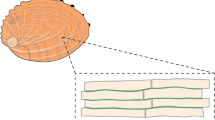Abstract
In the present research, microstructure of a kind of limnetic shell (Hyriopsis cumingii) is observed and measured by using the scanning electron microscopy, and mechanical behavior experiments of the shell nacre are carried out by using bending and tensile tests. The dependence of mechanical properties of the shell nacre on its microstructure is analyzed by using a modified shear-lag model, and the overall stress–strain relation is obtained. The experimental results reveal that the mechanical properties of shell nacre strongly depend on the water contents of the limnetic shell. Dry nacre shows a brittle behavior, whereas wetting nacre displays a strong ductility. Compared to the tensile test, the bending test overestimates the strength and underestimates the Young’s modulus. The modified shear-lag model can characterize the deformation features of nacre effectively.
Similar content being viewed by others
References
Curry J.D. (1977). Mechanical properties of mother of pearl in tension. Proc. R. Soc. London B 196: 443–463
Kamat S., Su X., Ballarini R. and Heuer A.H. (2000). Structural basis for the fracture toughness of the shell of the conch Strombus gigas. Nature 405: 1036–1040
Jackson A.P., Vincent J.F.V. and Turner R.M. (1988). The mechanical design of nacre. Proc. R. Soc. London B 234: 415–440
Menig R., Meyers M.H., Meyers M.A. and Vecchio K.S. (2000). Quasi-static and dynamic mechanical response of haliotis rufescens (abalone) shells. Acta Mater. 48: 2383–2398
Menig R., Meyers M.H., Meyers M.A. and Vecchio K.S. (2001). Quasi-static and dynamic mechanical response of strombus gigas (conch) shells. Mater. Sci. Eng. A 297: 203–211
Almqvist N., Thomson N.H., Smith B.L., Stucky G.D., Morse D.E. and Hansma P.K. (1999). Methods for fabricating and characterizing a new generation of biomimetic materials. Mater. Sci. Eng. C 7: 37–43
Jackson A.P. and Vincent J.F.V. (1999). Comparason of nacre with other ceramic composites. J. Mater. Sci. 25: 3173–3178
Wang R.Z., Suo Z., Evans A.G., Yao N. and Aksay I.A. (2001). Deformation mechanisms in nacre. J. Mater. Res. 16: 2485–2493
Evans A.G., Suo Z., Wang R.Z., Aksay I.A., He M.Y. and Hutchinson J.W. (2001). Model for the robust mechanical behavior of nacre. J. Mater. Res. 16: 2475–2484
Song F., Soh A.K. and Bai Y.L. (2003). Structural and mechanical properties of the organic matrix layers of nacre. Biomaterials 24: 3621–3631
Song F. and Bai Y.L. (2003). Effects of nanstructures on the fracture strength of the interfaces in nacre. J. Mater. Res. 18(8): 1741–1744
Song F. and Bai Y.L. (2001). Mineral bridges of nacre and its effects. Acta Mech. Sin. 17(3): 251–257 doi:10.1007/BF02486881
Katti K.S., Katti D.R., Pradhan S.M. and Bhosle A. (2005). Platelet interlocks are the key to toughness and strength in nacre. J. Mater. Res. 20(5): 1097–1100
Barthelata F., Tang H., Zavattieri P.D., Li C.M. and Espinos H.D. (2006). On the mechanics of mother-of-pearl: A key feature in the material hierarchical structure. J. Mech. Phys. Solids 55(2): 306–337
Wang R.Z., Wen H.B. and Cui F.Z. (1995). Observation of damage morphologies in nacre during deformation and fracture. J. Mater. Sci. 30: 2299–2304
Bruet B.J.F., Qi H.J., Boyce M.C., Panas R., Tai K., Frick L. and Ortiz C. (2005). Nanoscale morphology and indentation of individual nacre tablets from the gastropod mollusc trochus niloticus. J. Mater. Res. 20(11): 3157–3157
Gao H., Ji B., JKager I.L., Arzt E. and Fratzl P. (2003). Materials become insensitive to flaws at nanoscale:lessons from nature. Proc. Natl. Acad. Sci. USA 100: 5597–5600
Ji B. and Gao H. (2004). Mechanical properties of nanostructure of biological materials. J. Mech. Phys. Solids 52: 1963–1990
Kotha S.P., Li Y. and Guzelsu N. (2001). Micromechanical model of nacre tested in tension. J. Mater. Sci. 36: 2001–2007
Sarikaya, M., Gunnison, K.E., Yasrebi, M., Milius, D.L., Aksay, I.A.: Seashells as a natural model to study laminated composites. In: Biotechnology and Composite Materials, Am. Soc. Comp. Proc. Fifth Tech. Conf., Technomic, Lancaster, PA, 176 pp. (1990)
Author information
Authors and Affiliations
Corresponding author
Additional information
The project supported by the National Natural Science Foundation of China (10432050, 10428207 and 10672163), the Chinese Academy of Sciences (KJCX2-YW-M04) and the Institute of Mechanics through Innovation Project.
Rights and permissions
About this article
Cite this article
Zuo, S., Wei, Y. Microstructure observation and mechanical behavior modeling for limnetic nacre. Acta Mech. Sin. 24, 83–89 (2008). https://doi.org/10.1007/s10409-007-0125-y
Received:
Revised:
Accepted:
Published:
Issue Date:
DOI: https://doi.org/10.1007/s10409-007-0125-y




